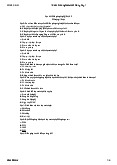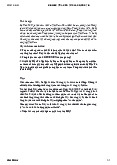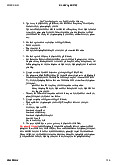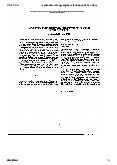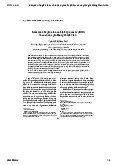









Preview text:
18:59 1/8/24 Reading READING PASSAGE 1
You should spend about 20 minutes on Questions 1-13 which are based on Reading Passage 1 below. The dugong: Sea cow
Dugongs are herbivorous mammals that spend their entire lives in the sea. Their close relatives the
manatees also venture into or live in freshwater. Together dugongs and manatees make up the order
Sirenia or sea cows, so-named because dugongs and manatees are thought to have given rise to the myth
of the mermaids or sirens of the sea. A
The dugong, which is a large marine mammal which, together with the manatees, looks rather
like a cross between a rotund dolphin and a walrus. Its body, flippers and fluke resemble those of
a dolphin but it has no dorsal fin. Its head looks somewhat like that of a walrus without the long tusks. B
Dugongs, along with other Sirenians whose diet consists mainly of sea-grass; and the distribution
of dugongs very closely follows that of these marine flowering plants. As seagrasses grow rooted
in the sediment, they are limited by the availability of light. Consequently they are found
predominantly in shallow coastal waters, and so too are dugongs. But, this is not the whole story.
Dugongs do not eat all species of seagrass, preferring seagrass of higher nitrogen and lower fibre content. C
Due to their poor eyesight, dugongs often use smell to locate edible plants. They also have a
strong tactile sense, and feel their surroundings with their long sensitive bristles. They will dig
up an entire plant and then shake it to remove the sand before eating it. They have been known to
collect a pile of plants in one area before eating them. The flexible and muscular upper lip is
used to dig out the plants. When eating they ingest the whole plant, including the roots, although
when this is impossible they will feed on just the leaves. A wide variety of seagrass has been
found in dugong stomach contents, and evidence exists they will eat algae when seagrass is
scarce. Although almost completely herbivorous, they will occasionally eat invertebrates such as
jellyfish, sea squirts, and shellfish. D
A heavily grazed seagrass bed looks like a lawn mown by a drunk. Dugongs graze apparently at
random within a seagrass bed, their trails meandering in all directions across the bottom. This is
rather an inefficient means of removing seagrass that results in numerous small tufts remaining.
And this is where the dugongs derive some advantage from their inefficiency. The species that
recover most quickly from this disturbance, spreading out vegetatively from the remaining tufts,
are those that dugongs like to eat. In addition, the new growth found in these areas tends to be
exactly what hungry dugongs like. E about:blank 1/10 18:59 1/8/24 Reading
Dugongs are semi-nomadic, often travelling long distances in search of food, but staying within a
certain range their entire life. Large numbers often move together from one area to another. It is
thought that these movements are caused by changes in seagrass availability. Their memory
allows them to return to specific points after long travels. Dugong movements mostly occur
within a localised area of seagrass beds, and animals in the same region show individualistic patterns of movement. F
Recorded numbers of dugongs are generally believed to be lower than actual numbers, due to a
lack of accurate surveys. Despite this, the dugong population is thought to be shrinking, with a
worldwide decline of 20 per cent in the last 90 years. They have disappeared from the waters of
Hong Kong, Mauritius, and Taiwan, as well as parts of Cambodia, Japan, the Philippines and
Vietnam. Further disappearances are likely. (In the late 1960s, herds of up to 500 dugongs were
observed off the coast of East Africa and nearby islands. However, current populations in this
area are extremely small, numbering 50 and below, and it is thought likely they will become
extinct. The eastern side of the Red Sea is the home of large populations numbering in the
hundreds, and similar populations are thought to exist on the western side. In the 1980s, it was
estimated there could be as many as 4,000 dugongs in the Red Sea. The Persian Gulf has the
second-largest dugong population in the world, inhabiting most of the southern coast, and the
current population is believed to be around 7,500. Australia is home to the largest population,
stretching from Shark Bay in Western Australia to Moreton Bay in Queensland. The population
of Shark Bay is thought to be stable with over 10,000 dugongs. G
Experience from various parts of northern Australia suggests that Extreme weather such as
cyclones and floods can destroy hundreds of square kilometres of seagrass meadows, as well as
washing dugongs ashore. The recovery of seagrass meadows and the spread of seagrass into new
areas, or areas where it has been destroyed, can take over a decade. For example, about 900 km2
of seagrass was lost in Hervey Bay in 1992, probably because of murky water from flooding of
local rivers, and run-off turbulence from a cyclone three weeks later. Such events can cause
extensive damage to seagrass communities through severe wave action, shifting sand and
reduction in saltiness and light levels. Prior to the 1992 floods, the extensive seagrasses in
Hervey Bay supported an estimated 1750 dugongs. Eight months after the floods the affected
area was estimated to support only about 70 dugongs. Most animals presumably survived by
moving to neighbouring areas. However, many died attempting to move to greener pastures, with
emaciated carcasses washing up on beaches up to 900km away. H
If dugongs do not get enough to eat they may calve later and produce fewer young. Food
shortages can be caused by many factors, such as a loss of habitat, death and decline in quality of
seagrass, and a disturbance of feeding caused by human activity. Sewage, detergents, heavy
metal, hypersaline water, herbicides, and other waste products all negatively affect seagrass
meadows. Human activity such as mining, trawling, dredging, land-reclamation, and boat
propeller scarring also cause an increase in sedimentation which smothers seagrass and prevents
light from reaching it. This is the most significant negative factor affecting seagrass. One of the about:blank 2/10 18:59 1/8/24 Reading
dugong’s preferred species of seagrass, Halophila ovalis, declines rapidly due to lack of light,
dying completely after 30 days. I
Despite being legally protected in many countries, the main causes of population decline remain
anthropogenic and include hunting, habitat degradation, and fishing-related fatalities.
Entanglement in fishing nets has caused many deaths, although there are no precise statistics.
Most issues with industrial fishing occur in deeper waters where dugong populations are low,
with local fishing being the main risk in shallower waters. As dugongs cannot stay As dugongs
cannot stay underwater for a very long period, they are highly prone to deaths due to
entanglement. The use of shark nets has historically caused large numbers of deaths, and they
have been eliminated in most areas and replaced with baited hooks. Hunting has historically been
a problem too, although in most areas they are no longer hunted, with the exception of certain
indigenous communities. In areas such as northern Australia, hunting remains the greatest impact on the dugong population Questions 1-4 Summary
Complete the following summary of the paragraphs of Reading Passage, using NO MORE
THAN TWO WORDS from the Reading Passage for each answer.
Write your answers in boxes 1-4 on your answer sheet.
Dugongs are herbivorous mammals that spend their entire lives in the sea. Yet Dugongs are
picky on their feeding Seagrass, and only chose seagrass with higher _________ 1 and lower
fibre. To compensate for their poor eyesight, they use their
2 ……………_to feel their surroundings.
It is like Dugongs are “farming” seagrass. They often leave
3………… randomly in all
directions across the sea bed. Dugongs prefer eating the newly grew seagrass recovering from
the tiny ___ left behind by the grazing dugongs. 4 Questions 5-9
Do the following statements agree with the information given in Reading Passage 1?
In boxes 5-9 on your answer sheet, write
TRUE if the statement is True
FALSE if the statement is false NOT GIVEN
If the information is not given in the passage
5 The dugong will keep eating up the plant completely when they begin to feed.
6 It takes more than ten years for the re-growth of seagrass where it has been grazed by Dugongs. about:blank 3/10 18:59 1/8/24 Reading
7 Even in facing food shortages, the strong individuals will not compete with the weak small ones for food.
8 It is thought that the dugong rarely returns to the old habitats when they finished the plant.
9 Coastal industrial fishing poses the greatest danger to dugongs which are prone to be killed due to entanglement. Questions 10-13 Answer the questions below.
Choose NO MORE THAN TWO WORDS AND/OR A NUMBER from the passage for each answer.
10 What is Dugong in resemblance to yet as people can easily tell them apart from the manatees by its tail?
11 What is the major reason Dugongs traveled long distances in herds from one place to another?
12 What number, has estimated to be, of dugong’s population before the 1992 floods in Hervey Bay took place?
13 What is thought to be the lethal danger when dugongs were often trapped in? READING PASSAGE 2
You should spend about 20 minutes on Questions 14-26 which are based on Reading Passage 2 below.
EUROPEAN TRANSPORT SYSTEMS 1990-2010
What have been the trends and what are the prospects for European transport systems? A
It is difficult to conceive of vigorous economic growth without an efficient transport system.
Although modern information technologies can reduce the demand for physical transport by
facilitating teleworking and teleservices, the requirement for transport continues to increase.
There are two key factors behind this trend. For passenger transport, the determining factor is the
spectacular growth in car use. The number of cars on European Union (EU) roads saw an
increase of three million cars each year from 1990 to 2010, and in the next decade the EU will
see a further substantial increase in its fleet. B
As far as goods transport is concerned, growth is due to a large extent to changes in the European
economy and its system of production. In the last 20 years, as internal frontiers have been
abolished, the EU has moved from a ‘stock’ economy to a ‘flow’ economy. This phenomenon
has been emphasized by the relocation of some industries, particularly those which are labour
intensive, to reduce production costs, even though the production site is hundreds or even
thousands of kilometers away from the final assembly plant or away from users. C about:blank 4/10 18:59 1/8/24 Reading
The strong economic growth expected in countries which are candidates for entry to the EU will
also increase transport flows, in particular road haulage traffic. In 1998, some of these countries
already exported more than twice their 1990 volumes and imported more than five times their
1990 volumes. And although many candidate countries inherited a transport system which
encourages rail, the distribution between modes has tipped sharply in favor of road transport
since the 1990s. Between 1990 and 1998, road haulage increased by 19.4%, while during the
same period rail haulage decreased by 43.5%, although – and this could benefit the enlarged EU
– it is still on average at a much higher level than in existing member states. D
However, a new imperative-sustainable development – offers an opportunity for adapting the
EU’s common transport policy. This objective, agreed by the Gothenburg European Council, has
to be achieved by integrating environmental considerations into Community policies, and
shifting the balance between modes of transport lies at the heart of its strategy. The ambitious
objective can only be fully achieved by 2020, but proposed measures are nonetheless a first
essential step towards a sustainable transport system which will ideally be in place in 30 years‟ time, that is by 2040. E
In 1998, energy consumption in the transport sector was to blame for 28% of emissions of CO2,
the leading greenhouse gas. According to the latest estimates, if nothing is done to reverse the
traffic growth trend, CO2 emissions from transport can be expected to increase by around 50% to
1,113 billion tonnes by 2020 , compared with the 739 billion tonnes recorded in 1990. Once
again, road transport is the main culprit since it alone accounts for 84% of the CO2 emissions
attributable to transport. Using alternative fuels and improving energy efficiency is thus both an
ecological necessity and a technological challenge. F
At the same time greater efforts must be made to achieve a modal shift. Such a change cannot be
achieved overnight, all the less so after over half a century of constant deterioration in favour of
road. This has reached such a pitch that today rail freight services are facing marginalisation,
with just 8% of market share, and with international goods trains struggling along at an average
speed of 18km/h. Three possible options have emerged. G
The first approach would consist of focusing on road transport solely through pricing. This
option would not be accompanied by complementary measures in the other modes of transport.
In the short term it might curb the growth in road transport through the better loading ratio of
goods vehicles and occupancy rates of passenger vehicles expected as a result of the increase in
the price of transport. However, the lack of measures available to revitalise other modes of
transport would make it impossible for more sustainable modes of transport to take up the baton. H
The second approach also concentrates on road transport pricing but is accompanied by measures
to increase the efficiency of the other modes (better quality of services, logistics, technology).
However, this approach does not include investment in new infrastructure, nor does it guarantee about:blank 5/10 18:59 1/8/24 Reading
better regional cohesion. It could help to achieve greater uncoupling than the first approach, but
road transport would keep the lion’s share of the market and continue to concentrate on saturated
arteries, despite being the most polluting of the modes. It is therefore not enough to guarantee the
necessary shift of the balance. I
The third approach, which is not new, comprises a series of measures ranging from pricing to
revitalising alternative modes of transport and targeting investment in the trans-European
network. This integrated approach would allow the market shares of the other modes to return to
their 1998 levels and thus make a shift of balance. It is far more ambitious than it looks, bearing
in mind the historical imbalance in favour of roads for the last fifty years, but would achieve a
marked break in the link between road transport growth and economic growth, without placing
restrictions on the mobility of people and goods. Questions 1-8
Reading Passage 2 has nine paragraphs, . A-I
Choose the correct heading for paragraphs A-E and from the list of headings G-I below.
Write the correct number, , in boxes i-xi
14-21 on your answer sheet. List of Headings i
A fresh and important long-term goal ii
Charging for roads and improving other transport methods iii
Changes affecting the distances goods may be transported iv
Taking all the steps necessary to change transport patterns v
The environmental costs of road transport vi
The escalating cost of rail transport
vii The need to achieve transport rebalance
viii The rapid growth of private transport ix
Plans to develop major road networks x
Restricting road use through charging policies alone xi
Transport trends in countries awaiting EU admission 14 Paragraph A 15 Paragraph B 16 Paragraph C 17 Paragraph D 18 Paragraph E Example Answer Paragraph F vii 19 Paragraph G 20 Paragraph H 21 Paragraph I Questions 22-26
Do the following statements agree with the information given in Reading Passage 2?
In boxes 22-26 on your answer sheet, write
TRUE if the statement agrees with the information about:blank 6/10 18:59 1/8/24 Reading
FALSE if the statement contradicts the information NOT GIVEN
if there is no information on this
22 The need for transport is growing, despite technological developments.
23 To reduce production costs, some industries have been moved closer to their relevant consumers.
24 Cars are prohibitively expensive in some EU candidate countries.
25 The Gothenburg European Council was set up 30 years ago.
26 By the end of this decade, CO2 emissions from transport are predicted to reach 739 billion tonnes. READING PASSAGE 3
You should spend about 20 minutes on Questions 27-40 which are based on Reading Passage 3 below. Thinking, Fast and Slow
The idea that we are ignorant of our true selves surged in the 20th century and became common.
It’s still a commonplace, but it’s changing shape. These days, the bulk of the explanation is done
by something else: the ‘dual-process’ model of the brain. We now know that we apprehend the
world in two radically opposed ways, employing two fundamentally different modes of thought:
‘System 1’ and ‘System 2’. System 1 is fast; it’s intuitive, associative and automatic and it can’t
be switched off. Its operations involve no sense of intentional control, but it’s the “secret author
of many of the choices and judgments you make” and it’s the hero of Daniel Kahneman’s
alarming, intellectually stimulating book Thinking, Fast and Slow.
System 2 is slow, deliberate and effortful. Its operations require attention. (To set it going now,
ask yourself the question “What is 13 x 27?”). System 2 takes over, rather unwillingly, when
things get tricky. It’s “the conscious being you call ‘I'”, and one of Kahneman’s main points is
that this is a mistake. You’re wrong to identify with System 2, for you are also and equally and
profoundly System 1. Kahneman compares System 2 to a supporting character who believes
herself to be the lead actor and often has little idea of what’s going on.
System 2 is slothful, and tires easily (a process called ‘ego depletion’) – so it usually accepts
what System 1 tells it. It’s often right to do so, because System 1 is for the most part pretty good
at what it does; it’s highly sensitive to subtle environmental cues, signs of danger, and so on. It
does, however, pay a high price for speed. It loves to simplify, to assume WYSIATI (‘what you
see is all there is’). It’s hopelessly bad at the kind of statistical thinking often required for good
decisions, it jumps wildly to conclusions and it’s subject to a fantastic range of irrational
cognitive biases and interference effects, such as confirmation bias and hindsight bias, to name but two.
The general point about our self-ignorance extends beyond the details of Systems 1 and 2. We’re
astonishingly susceptible to being influenced by features of our surroundings. One famous (pre-
mobile phone) experiment centred on a New York City phone booth. Each time a person came
out of the booth after having made a call, an accident was staged – someone dropped all her
papers on the pavement. Sometimes a dime had been placed in the phone booth, sometimes not about:blank 7/10 18:59 1/8/24 Reading
(a dime was then enough to make a call). If there was no dime in the phone booth, only 4% of
the exiting callers helped to pick up the papers. If there was a dime, no fewer than 88% helped.
Since then, thousands of other experiments have been conducted, all to the same general effect.
We don’t know who we are or what we’re like, we don’t know what we’re really doing and we
don’t know why we’re doing it. For example, Judges think they make considered decisions about
parole based strictly on the facts of the case. It turns out (to simplify only slightly) that it is their
blood-sugar levels really sitting in judgment. If you hold a pencil between your teeth, forcing
your mouth into the shape of a smile, you’ll find a cartoon funnier than if you hold the pencil
pointing forward, by pursing your lips round it in a frown-inducing way.
In an experiment designed to test the ‘anchoring effect’, highly experienced judges were given a
description of a shoplifting offence. They were then ‘anchored’ to different numbers by being
asked to roll a pair of dice that had been secretly loaded to produce only two totals – three or
nine. Finally, they were asked whether the prison sentence for the shoplifting offence should be
greater or fewer, in months, than the total showing on the dice. Normally the judges would have
made extremely similar judgments, but those who had just rolled nine proposed an average of
eight months while those who had rolled three proposed an average of only five months. All
were unaware of the anchoring effect.
The same goes for all of us, almost all the time. We think we’re smart; we’re confident we won’t
be unconsciously swayed by the high list price of a house. We’re wrong. (Kahneman admits his
own inability to counter some of these effects.) For example, another systematic error involves
‘duration neglect’ and the ‘peak-end rule’. Looking back on our experience of pain, we prefer a
larger, longer amount to a shorter, smaller amount, just so long as the closing stages of the
greater pain were easier to bear than the closing stages of the lesser one.
Questions 27-31. Choose the correct letter, A, B, or C D.
27 The dual process model of the brain is
A The common practice of thinking about two things at the same time.
B The conflicting impulses pushing the brain to make both more and less effort,
C The feeling of liking and not liking something simultaneously.
D The natural tendency to make sense of the world in two different ways.
28 System 2 takes charge of decision-making when
A When the brain needs a rest.
B When more mental effort is required.
C When a person feels excessively confident.
D When a dangerous situation is developing.
29 ‘Confirmation bias’ is an example of
A System 1 rushing to judgment.
B System 1 making a careful judgment.
C System 1 making a brave judgment
D System 1 judging a situation based on facts. about:blank 8/10 18:59 1/8/24 Reading
30 The main conclusion of the phone booth experiment was that
A People are more likely to help someone that they are attracted to.
B People are more responsive to their environment than they realize.
C People are more likely to be helpful if they think they will be rewarded.
D People are generally selfish and will always do what is best for themselves.
31 The ‘anchoring effect’ is the process by which
A Decisions are made using a numerical system.
B A subconscious factor may strongly influence our decision-making
C Decisions about prison sentences are made by rolling a dice.
D We may emphasize certain factor too much in our decision-making. Questions 32-36
Do the following statements agree with the claims of the writer in Reading Passage 3?
In boxes 32-36 on your answer sheet, write
TRUE if the statement agrees with the claims of the writer
NO if the statement contradicts the claims of the writer
NOT GIVEN if it is impossible to say what the writer thinks about this
32 In general, humans have become less rational over the last 100 years.
33 Most people lack a clear sense of their own personal identity.
34 A person can train themselves to use System 2 most of the time.
35 People who make important decisions should be made aware of the dual-process model.
36 In most everyday situations, people are capable of making calm and rational decisions. Questions 37-39
Complete each sentence with the correct ending, A-E, below.
Write the correct letter, A-E, in boxes 37-39 on your answer sheet.
37 In the course of evolutionary history System 1 has served humans well because
38 Low blood sugar or tiredness may be factors in decision making because
39 The ‘peak-end rule’ shows us that
A feeling a certain way at the conclusion of an experience decides how we remember it.
B decision-making and judgments are made too quickly.
C having less energy means we are more likely to succumb to an irrational bias.
D being sensitive to ones’ surroundings is a useful survival skill.
E wanting more food or drink may distract us from the decision we are making. Question 40
Choose the correct letter, A, B, C or D. about:blank 9/10 18:59 1/8/24 Reading
Write the correct letter in box on your answer sheet. 40
What is the writer’s primary purpose in writing this article?
A to introduce their own research to the general reader
B to summarize and review a recently published book
C to argue against a commonly-held theory
D to encourage readers to question their own decision-making processes. about:blank 10/10
